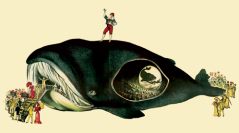

 Anthropozoologica
54 (3) - Pages 13-27
Anthropozoologica
54 (3) - Pages 13-27Whale, a common name, a simple word, but so many meanings. An animal, a good, a belief, a surprise, a part of these aspects or the encompassing of them all. It is, for sure, a being of some kind, but one that is described, depicted and appropriated in several forms, in a multitude of ways. To the whale is always assigned a role, but its relevance to distinct groups of society and its presentation to diverse audiences, across history, can be very different from one type of source to another. Working from the question – what’s in a whale? – we present a study on the long-term human-whale relationships (from the 13th century onwards) connecting history and literature, to highlight the deep entanglement of societies and cultures with the marine environment. We aim at understanding the significance of whales and how culture, knowledge and values determine human behavior and actions towards these mammals. For that, we run through a long timeframe analyzing the whale, mostly based on Portuguese written sources, in comparison with European data, to discuss it as a commodity, a monster, a show and an icon. What we find is that the whale – real or conceptualized – has continuously been an element of human fascination. It is not merely a whale, but a wonder whale. An animal that still attracts crowds of people when it strands on nearby shores or when its blow is spotted in the horizon. The wonder whale allows for a close connection of people with the strange, enormous, paradoxical, ambivalent, still much unknown, oceanic realm.
Cetaceans, stranding, whaling, perceptions, values.